
Thursday, April 30, 2009
The last ride in the derty south. Dupont State Forest.
Well today was my last ride in the now hot and green and beautiful (as usual) South Carolina. Well err ok I guess technically we rode in North Carolina but it was still 25 degrees so I wasn't complaining. Took in the regular loop, wasn't interested in doing a long exploration ride today since I'm on an off week. Did get some good photos to share with ya'll and to help me recruit more anxious cabin fever suffering riders to enjoy the area when I get the house for next year. Anyway enough text, I know all you really want is the photos. The other guy in the pics/vid is my friendly friend Gareth, a co-worker from Hardwood Ski and Bike.


Wednesday, April 29, 2009
The countdown
Well I'm afraid it is getting to be that time. This is my last week in beautiful South Carolina and I must say the weather has really given us a nice going away present. It has been 30+ degrees and sunny here every day for the past week and a half. Having been here for almost 9 weeks I am obviously looking forward to getting back to Canada. I can use my debit card again, pick up where I left off with the Canadian Tire flyers, oh and I guess go visit the family for a couple days. I'll be getting the house again next year so keep in touch for details in the next couple months if you are interested in coming down again or for the first time.
Sunday, April 26, 2009
SERC XC Race - Winder, Georgia.
Well after my initial impression of the course being super boring I found it to be a little more entertaining since they shortened the lap a little which gave it a bit more flow. Race was going good until I got some major stomach crampage 1/2 way through. I was pretty much reduced to keeping my heartrate below 150 BPM and couldn't flow anything because every bump hurt like hell. Now this was the first time such a thing has ever happened to me in a race so now begins the analysis of why I sucked so bad. Actually the analysis started while I was still "racing" as I tried to figure out what could have caused this. I'm not one for excuses, more like I want to figure out what happened so I can try and keep it from happening again. So here's a short list of routine irregularities that I came up with.
Early morning start / lack of sleep - I found out last night the race started at 9:30am, not the 11:30am start that I thought it was. So I packed up the car right away and got ready last night but still didn't get to bed until 11:30pm. I had to get up at 5:30am to get there in time.
Caffeinated gels - I used 2x caffeine PowerGels. Now this is not a change from what I regularly use but being this was only the 2nd race of the year perhaps my body couldn't handle them. Unlikely but still a possibility.
Lack of sustained intensity in training - I have been doing lots of LSD rides and intervals but nothing really sustained for a longer period of time. Maybe this is why I was good for an hour 15min before it happened.
Conclusion - Pretty much I think it was a combo of all three. The major player being a lack of sustained intensity. So I plan to hit up some club rides and weekly race series in the next couple weeks to build this back up. I'm also going to use some of the caffeinated gels when I do this to make sure that I get used to them. I am also going back to a more reasonable sleep schedule because believe it or not I have to go back to work soon lol. I guess there is a 4th possibility, I'm getting old :-(
I think I'll still be good to go for the important races.
Benno
Early morning start / lack of sleep - I found out last night the race started at 9:30am, not the 11:30am start that I thought it was. So I packed up the car right away and got ready last night but still didn't get to bed until 11:30pm. I had to get up at 5:30am to get there in time.
Caffeinated gels - I used 2x caffeine PowerGels. Now this is not a change from what I regularly use but being this was only the 2nd race of the year perhaps my body couldn't handle them. Unlikely but still a possibility.
Lack of sustained intensity in training - I have been doing lots of LSD rides and intervals but nothing really sustained for a longer period of time. Maybe this is why I was good for an hour 15min before it happened.
Conclusion - Pretty much I think it was a combo of all three. The major player being a lack of sustained intensity. So I plan to hit up some club rides and weekly race series in the next couple weeks to build this back up. I'm also going to use some of the caffeinated gels when I do this to make sure that I get used to them. I am also going back to a more reasonable sleep schedule because believe it or not I have to go back to work soon lol. I guess there is a 4th possibility, I'm getting old :-(
I think I'll still be good to go for the important races.
Benno
Saturday, April 25, 2009
How-To: Clean your drivetrain.
I often get asked just exactly how I get my drivetrain so clean. The answer is somewhat complicated and involved but once you get the steps down it's actually pretty easy and quick to do. It now takes me about 15 minutes from start to finish to complete the job, depending on how dirty it is in the first place. Here's what you'll need to get started.
-Bucket with water
-Chain whip
-Cassette tool
-Wrench
-Degreaser
-Toothbrush
-A rag or two
I have been using gloves with this brand of degreaser because I find it burns the skin off my hands. I typically use degreaser called Mean Green, which is what the bottle in the picture is. Either way it pretty much all works well. Get stuff that is eco friendly.
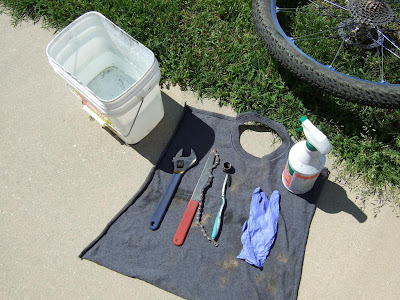
Lets see what we're dealing with here. Nothing too crazy since I do this about once a week (depending on trail conditions and how much I'm riding).
-Bucket with water
-Chain whip
-Cassette tool
-Wrench
-Degreaser
-Toothbrush
-A rag or two
I have been using gloves with this brand of degreaser because I find it burns the skin off my hands. I typically use degreaser called Mean Green, which is what the bottle in the picture is. Either way it pretty much all works well. Get stuff that is eco friendly.

Lets see what we're dealing with here. Nothing too crazy since I do this about once a week (depending on trail conditions and how much I'm riding).
Shift your rear derailleur into the smalled cog on the back so that the rear wheel is easier to remove.
Remove your skewer from the rear wheel and re-assemble it so that you don't lose any springs or parts from it.

With the skewer out of the way you can insert the cassette tool. Essentially it is a spline to hex nut interface allowing you to loosen the cassette lockring.

The next part can be a little tricky the first couple times you try and do it. You need to use a tool called a chain whip, which is the red handled tool you see. Its job is to stop the cassette from spinning when you are turning the wrench to loosen the lockring. Make sure you wrap the chain from the whip around a larger cog so that it can get a good hold and not damage your nice XTR cassette in any way. Holding the chain whip you can now loosen the cassette lockring by turning the blue handled wrench counter clockwise.

Lift the cassette off and you will reveal your freehub body. Make sure to keep good track of any spacers or parts that you are pulling off the freehub. Many wheels like Mavic and Shimano will have spacers that shim the cassette away from the wheel. Many cassettes will have spacers that separate the cogs from each other. In my case I have none of these. The Cobalts have no shims and the XTR 970 (new generation) cassette has no cog spacers. Put all parts including the cassette lockring together on a rag.
Feel free to take a little time to clean it this area on your wheel up. After all that's why we're here in the first place. You can now access hard to reach areas like the hub and lower spokes.

Now lets tackle that dirty cassette. Spray it down with degreaser and use the toothbrush to get all the crap off.
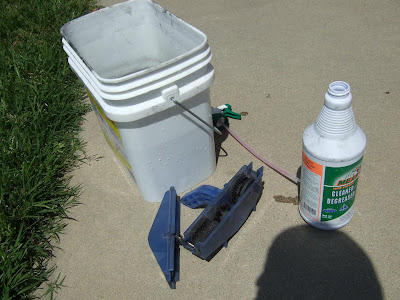
Fill the chain cleaner to the fill line with degreaser. For this tool the fill line is roughly 1/2 way.

Snap it together over the chain. I am putting it over the chain stay because I will be rotating the crank clockwise. This way it pulls the chain through the cleaner with no problem. Give it a good amount of rotations (15ish) to let the degreaser really do its job.

Take the chain cleaner off the chain and pour out any remaining degreaser (remember it's biodegradable :-D ). Rinse the cleaner out in your bucket of water to get out any dirty degreaser. Fill it back up to the fill line with clean degreaser and do it all over again. I always run 2 cycles of degreaser, takes an extra 30 seconds but leaves you with a much deeper clean.

After rinsing the chain cleaner out from the 2nd cycle of degreaser go ahead and fill it up to the brim with water (don't worry about the water being crystal clean, it's still good enough).

Run the chain through the chain cleaner full of water just like you did when it had degreaser in it. Remember the degreaser is still on the chain and is dirty and potentially corrosive so you gotta get it off of there. When you have completed 15-20 rotations of the cranks remove the chain cleaner, rinse it out and then fill it back up and do another cycle of water. Again doing this twice only takes an extra 30 seconds and gives you a much cleaner chain.

With the skewer out of the way you can insert the cassette tool. Essentially it is a spline to hex nut interface allowing you to loosen the cassette lockring.

The next part can be a little tricky the first couple times you try and do it. You need to use a tool called a chain whip, which is the red handled tool you see. Its job is to stop the cassette from spinning when you are turning the wrench to loosen the lockring. Make sure you wrap the chain from the whip around a larger cog so that it can get a good hold and not damage your nice XTR cassette in any way. Holding the chain whip you can now loosen the cassette lockring by turning the blue handled wrench counter clockwise.

Lift the cassette off and you will reveal your freehub body. Make sure to keep good track of any spacers or parts that you are pulling off the freehub. Many wheels like Mavic and Shimano will have spacers that shim the cassette away from the wheel. Many cassettes will have spacers that separate the cogs from each other. In my case I have none of these. The Cobalts have no shims and the XTR 970 (new generation) cassette has no cog spacers. Put all parts including the cassette lockring together on a rag.

Feel free to take a little time to clean it this area on your wheel up. After all that's why we're here in the first place. You can now access hard to reach areas like the hub and lower spokes.

Now lets tackle that dirty cassette. Spray it down with degreaser and use the toothbrush to get all the crap off.
The purpose of the degreaser is to make grease water soluble. You still need to clean off the dirty and potentially corrosive degreaser. Use your bucket of water to rinse each cog clean.

Once you have finished cleaning each cog just set them aside on a rag all together so you don't lose anything and let them dry.
Moving on to the next step, cleaning the chain. For this you'll need the same bucket of water, some more degreaser, and a chain cleaning tool like this Park Tools one. It is best to clean the chain with the back wheel off the bike. That way you don't have dirty degreaser finding its way into the freehub and bearings in your hub.

Fill the chain cleaner to the fill line with degreaser. For this tool the fill line is roughly 1/2 way.

Snap it together over the chain. I am putting it over the chain stay because I will be rotating the crank clockwise. This way it pulls the chain through the cleaner with no problem. Give it a good amount of rotations (15ish) to let the degreaser really do its job.

Take the chain cleaner off the chain and pour out any remaining degreaser (remember it's biodegradable :-D ). Rinse the cleaner out in your bucket of water to get out any dirty degreaser. Fill it back up to the fill line with clean degreaser and do it all over again. I always run 2 cycles of degreaser, takes an extra 30 seconds but leaves you with a much deeper clean.

After rinsing the chain cleaner out from the 2nd cycle of degreaser go ahead and fill it up to the brim with water (don't worry about the water being crystal clean, it's still good enough).

Run the chain through the chain cleaner full of water just like you did when it had degreaser in it. Remember the degreaser is still on the chain and is dirty and potentially corrosive so you gotta get it off of there. When you have completed 15-20 rotations of the cranks remove the chain cleaner, rinse it out and then fill it back up and do another cycle of water. Again doing this twice only takes an extra 30 seconds and gives you a much cleaner chain.
Dry your chain off with a clean rag.
Now that your chain is sparkling clean lets get back to assembling the cassette since it should now be dry. Your cogs will only go onto the freehub one way so don't worry about doing it wrong. The only thing you need to worry about is making sure they go on it order (largest to smallest) and that you reassemble any washers or spacers that were in there. Since you kept good track of all that stuff and this is not rocket science, you are prepared for this step.

A tip to remember is that the printing on the cogs faces up. Also look for the one big fat spline as a good reference.

Now gently start the threads for the cassette lockring. Be very careful threading this onto the freehub because the threads are delicate and some freehubs are soft alloy. I cannot stress enough that you do not want to cross thread this at all, take your time. Tighten it down, you won't need the chain whip. The freehub locks when you try to spin the cassette clockwise which is the direction you are turning the wrench to tighten. You don't need to reef on it with He-Man strength, on a tightening scale of 1 to 10 I give it a 7.
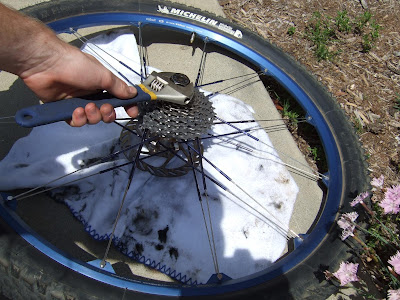
Now that your cassette and chain are clean you can finish the job by cleaning your pulley wheels and chainrings. I do this just by wiping with a clean rag. You can use some bike lust on the rag to help you get the gunk off. The reason I don't use degreaser on the chainrings is because they are too close to the bottom bracket. You don't want to seep dirty corrosive degreaser into your nice Chris King BB. If your cranks are so dirty that you want to clean em up really well then pull them off the bike. Doesn't take long, I'll show you how to do that later ;-)
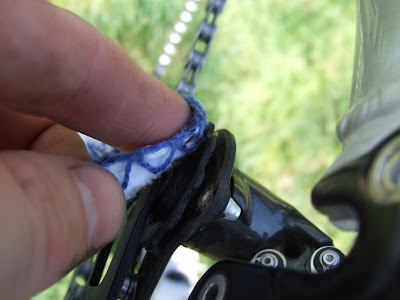
Now put the rear wheel back on the bike by holding it firmly against the dropouts while simultaneously tightening the quick release to make sure that it is square in the frame.
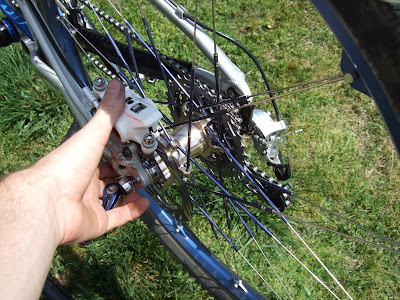
Here are a couple before and after shots.
Before
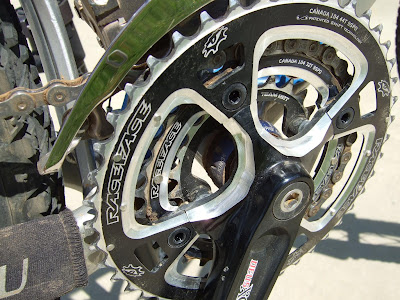
After

Before

After

All done and clean. Now lube your chain as soon as you are done to leave time for it to soak in.

A tip to remember is that the printing on the cogs faces up. Also look for the one big fat spline as a good reference.

Now gently start the threads for the cassette lockring. Be very careful threading this onto the freehub because the threads are delicate and some freehubs are soft alloy. I cannot stress enough that you do not want to cross thread this at all, take your time. Tighten it down, you won't need the chain whip. The freehub locks when you try to spin the cassette clockwise which is the direction you are turning the wrench to tighten. You don't need to reef on it with He-Man strength, on a tightening scale of 1 to 10 I give it a 7.

Now that your cassette and chain are clean you can finish the job by cleaning your pulley wheels and chainrings. I do this just by wiping with a clean rag. You can use some bike lust on the rag to help you get the gunk off. The reason I don't use degreaser on the chainrings is because they are too close to the bottom bracket. You don't want to seep dirty corrosive degreaser into your nice Chris King BB. If your cranks are so dirty that you want to clean em up really well then pull them off the bike. Doesn't take long, I'll show you how to do that later ;-)

Now put the rear wheel back on the bike by holding it firmly against the dropouts while simultaneously tightening the quick release to make sure that it is square in the frame.

Here are a couple before and after shots.
Before

After

Before

After

All done and clean. Now lube your chain as soon as you are done to leave time for it to soak in.
Questions, comments, suggestions, all welcome.
Tuesday, April 21, 2009
How-To: Center your caliper
Lets face the facts. Almost all bikes nowadays come with disk brakes whether they be mechanical or hydraulic. One of the more common problems surrounding disks is that they need adjusting every once in a while to get rid of any brake rub. Brake rub is when the rotor contacts the pads while the wheel is spinning freely. As you might have guessed an easy way to test for this is to lift your wheel off the ground and give it a spin. It should make at least a few revolutions without stopping or making any noise. Note: if you have liquid sealant in your tires like Stans it will reduce the amount of revolutions, not to be confused with brake rub :-) Today I am only going to cover how to center hydraulic disk brake calipers. There are many myths and techniques surrounds how to do this. From experience I have found the following method to be by far the fastest and most effective. Keep in mind there is a lot more to disk brakes then just centering them. I'll cover stuff like sticky pistons, lever throw, rotor straightening, and piston centering in other how-to's.
First step is also the most important. Make sure your wheels is centered in the frame or fork!!! There is nothing worse then taking the time to center the caliper and then realising your wheel wasn't straight in the dropouts. It happens to us all. Hold the wheel tight against the dropouts to keep it square while simultaneously tightening the quick release. Or you can do it while the bike is on the ground.

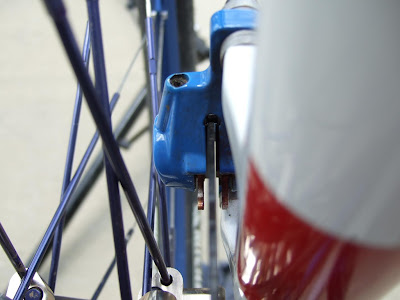 To reposition the caliper start by loosening the caliper bolts. Don't back them way off because usually the caliper is only off center by a little bit. If you loosen the bolts just a bit then the caliper should still be held in place but also be movable by hand.
To reposition the caliper start by loosening the caliper bolts. Don't back them way off because usually the caliper is only off center by a little bit. If you loosen the bolts just a bit then the caliper should still be held in place but also be movable by hand.
 This is what I mean by movable by hand. The caliper can now be moved to the left or right. Move it one side at a time.
This is what I mean by movable by hand. The caliper can now be moved to the left or right. Move it one side at a time.
 You can see now that there is an even gap on either side of the pads on one side of the caliper.
You can see now that there is an even gap on either side of the pads on one side of the caliper.
 Snug only the bolt on the side where there is now an even gap.
Snug only the bolt on the side where there is now an even gap.
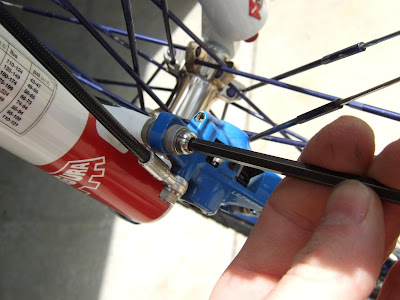 Now do the other side. Gently push the caliper on the other side to even up the gap between rotor and pads. Since you only snugged the bolt on the side you already adjusted and didn't tighten it down completely then you will still be able to move the caliper without messing up the proper gap you already have.
Now do the other side. Gently push the caliper on the other side to even up the gap between rotor and pads. Since you only snugged the bolt on the side you already adjusted and didn't tighten it down completely then you will still be able to move the caliper without messing up the proper gap you already have.

Now snug this bolt down. At this point your gaps should be pretty good and both bolts are snugged. Spin the wheel to see if there is any rub or noise. If there is then observe the spinning rotor moving through the caliper. If it rubs for only one portion of the rotation then you have a warped rotor. If it's not super warped then you should be able to readjust the caliper a little to compensate for this and still have no rub. If this isn't possible then you need to straighten your rotor. I'll cover this later :-)
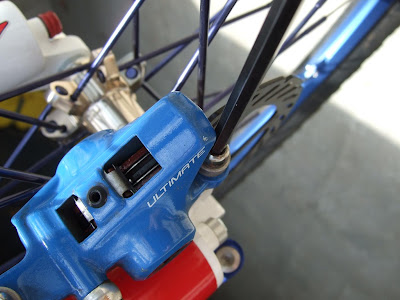
Now tighten down the bolts to your recommended torque specs. Sometimes the tightening of the bolts can shift the caliper a little. Spin the wheel again when you are all done to make sure there is still no rub.
First step is also the most important. Make sure your wheels is centered in the frame or fork!!! There is nothing worse then taking the time to center the caliper and then realising your wheel wasn't straight in the dropouts. It happens to us all. Hold the wheel tight against the dropouts to keep it square while simultaneously tightening the quick release. Or you can do it while the bike is on the ground.

For me, centering calipers has a lot to do with paying very close attention with my eyes and ears. I'm not going to tell you to squeeze the lever and tighten the bolts, or insert business cards yada yada yada. The process is pretty darn simple but requires a light touch. Be patient, it might be hard at first but gets easy quickly the more times you do it. First step, spin your wheel while looking at the gaps between pad and rotor. You should see daylight on each side, that is the cue that you are looking for. From this picture you can see that there is clearance on the right but not the left.
 To reposition the caliper start by loosening the caliper bolts. Don't back them way off because usually the caliper is only off center by a little bit. If you loosen the bolts just a bit then the caliper should still be held in place but also be movable by hand.
To reposition the caliper start by loosening the caliper bolts. Don't back them way off because usually the caliper is only off center by a little bit. If you loosen the bolts just a bit then the caliper should still be held in place but also be movable by hand. This is what I mean by movable by hand. The caliper can now be moved to the left or right. Move it one side at a time.
This is what I mean by movable by hand. The caliper can now be moved to the left or right. Move it one side at a time.  You can see now that there is an even gap on either side of the pads on one side of the caliper.
You can see now that there is an even gap on either side of the pads on one side of the caliper. Snug only the bolt on the side where there is now an even gap.
Snug only the bolt on the side where there is now an even gap. Now do the other side. Gently push the caliper on the other side to even up the gap between rotor and pads. Since you only snugged the bolt on the side you already adjusted and didn't tighten it down completely then you will still be able to move the caliper without messing up the proper gap you already have.
Now do the other side. Gently push the caliper on the other side to even up the gap between rotor and pads. Since you only snugged the bolt on the side you already adjusted and didn't tighten it down completely then you will still be able to move the caliper without messing up the proper gap you already have.
Now snug this bolt down. At this point your gaps should be pretty good and both bolts are snugged. Spin the wheel to see if there is any rub or noise. If there is then observe the spinning rotor moving through the caliper. If it rubs for only one portion of the rotation then you have a warped rotor. If it's not super warped then you should be able to readjust the caliper a little to compensate for this and still have no rub. If this isn't possible then you need to straighten your rotor. I'll cover this later :-)

Now tighten down the bolts to your recommended torque specs. Sometimes the tightening of the bolts can shift the caliper a little. Spin the wheel again when you are all done to make sure there is still no rub.
Note: I believe Avid's are the only caliper that are adjustable on 3 dimensions. This means they come with washers that allow you to rock the caliper. This is so that you can make sure the pads are completely square to the rotor in all dimensions. This makes adjustments a little more tricky but the technique stays the same. Adjust while looking for the gaps and snug the bolts when you feel you are getting close.
That's all there is to it. Practice makes perfect. Enjoy your drag free brakes and increased velocity!
Check this out for the super pro method of installing new brake pads and servicing a caliper.
Check this out for the super pro method of installing new brake pads and servicing a caliper.
Sunday, April 19, 2009
Testing: ArmorAll Bike Wash
 Well actually it's car wash but I figure if it's good enough for a Ferrari then it will probably work for the Giant. I'm trying this as a cheap alternative to bike lust or any other flavour of all purpose bike cleaner. This stuff costs about $5 for a jug. Directions say mix one ounce per gallon so I put a small squeeze into a spray bottle and filled the rest with water. Shake it up initially and probably give it a little shake just before you are about to use it. It contains some wax and other additives that help it remove bugs and grime and Gatorade ect.... Initial impressions are good. It gets the stuff off fairly easily and leaves your bike with a nice shine. Considering it costs around 25 cents to fill up a spray bottle I'd say it's a pretty good way to save some $.
Well actually it's car wash but I figure if it's good enough for a Ferrari then it will probably work for the Giant. I'm trying this as a cheap alternative to bike lust or any other flavour of all purpose bike cleaner. This stuff costs about $5 for a jug. Directions say mix one ounce per gallon so I put a small squeeze into a spray bottle and filled the rest with water. Shake it up initially and probably give it a little shake just before you are about to use it. It contains some wax and other additives that help it remove bugs and grime and Gatorade ect.... Initial impressions are good. It gets the stuff off fairly easily and leaves your bike with a nice shine. Considering it costs around 25 cents to fill up a spray bottle I'd say it's a pretty good way to save some $. Just spray it on a cloth or directly on the bike. I would try not to get any on the brake rotors though or in the pads.
 Wipe clean
Wipe clean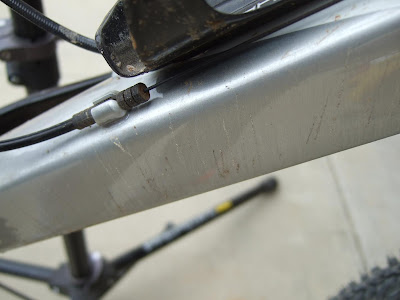
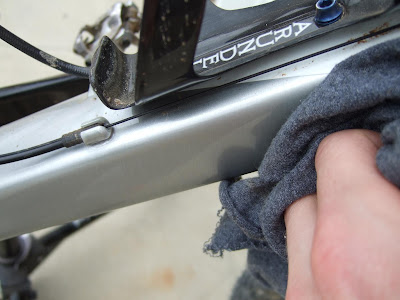

 That's all there is to it. I got this stuff at Canadian Tire and I give it the thumbs up.
That's all there is to it. I got this stuff at Canadian Tire and I give it the thumbs up.-July 4th/09 Update
Just used this stuff to clean my car. Worked great. Dunno if it was the wax additive or the fact that I polished it with a Shamwow but it is shiny and looks about as awesome as a stock civic can look ;-)
Saturday, April 18, 2009
Blog day 2
Well I did it. I added my first How-To. I'll just keep adding them as I do them for the most part. Today I went mountain biking in Dupont. Just hit up the same trails as usual because I got there kinda late. Managed about 2.5 hours which is a little short but my one calf has been protesting a little and I want to get in a good intervals session tomorrow. I did have a close encounter with a tree. Left me with the usual purple and red blotches on the forearm, shoulder, and hip. I do have to talk about how ridiculously awesome my new bike is. The rougher it gets it just magically conjures up more travel and smooths it all out. Seems like the faster and more aggressive you ride the more the bike responds in a positive way. I am really having a lot of fun on it! Stay tuned for a full review of it in the next little bit.
How-To: Lube your chain
I know what you're thinking. C'mon lube my chain? Well I like to cover the basics because even the basics can have little tricks that can help you save time and get the job done right. I have been experimenting with different lubes (insert sexually explicit joke of your choice here). I remember the Finish Line mechanic showing me his preferred method a couple years ago. I haven't been 100% happy with my current setup which was strictly an application of Finish Line Teflon lube. I would apply to both top and bottom of chain semi liberally and then wipe off the excess. I have found whenever the chain gets wet it quickly removes the Teflon and the chain starts to dry out. So that led me back to what I learned from the Finish Line guy and I thought I would try to put it into practice. I have experimented with different quantities and I think I have found a good balance.
 Step 1: Always start with a clean drive train. There is no point in slathering more lube over dirt, it's gotta be clean. My bike has been used and has been dirty, this is not a brand spankin' new drive train. So you know it is possible to get a drive train this clean and it's really not that hard. Click here for How-To: Clean your drive train :-)
Step 1: Always start with a clean drive train. There is no point in slathering more lube over dirt, it's gotta be clean. My bike has been used and has been dirty, this is not a brand spankin' new drive train. So you know it is possible to get a drive train this clean and it's really not that hard. Click here for How-To: Clean your drive train :-)
 Step 2: Apply a thin bead of Cross Country (green lid). Do this by holding the bottle to the chain and gently squeeze the bottle while simultaneously spinning the cranks backwards. You'll see a thin line of lube coming out and onto the moving chain. Do this for roughly two whole revolutions of the chain being careful not to apply too much. Too much of this lube will make your chain more vulnerable to dirt. The lube will glob up around your cassette and chain rings and pulley wheels and just keep attracting dirt. Apply the same thin bead to the other side of the chain under the chain stay.
Step 2: Apply a thin bead of Cross Country (green lid). Do this by holding the bottle to the chain and gently squeeze the bottle while simultaneously spinning the cranks backwards. You'll see a thin line of lube coming out and onto the moving chain. Do this for roughly two whole revolutions of the chain being careful not to apply too much. Too much of this lube will make your chain more vulnerable to dirt. The lube will glob up around your cassette and chain rings and pulley wheels and just keep attracting dirt. Apply the same thin bead to the other side of the chain under the chain stay. Step 3: Work the Cross Country lube into the chain by rubbing it in with your fingers while spinning the cranks backwards.
Step 3: Work the Cross Country lube into the chain by rubbing it in with your fingers while spinning the cranks backwards.
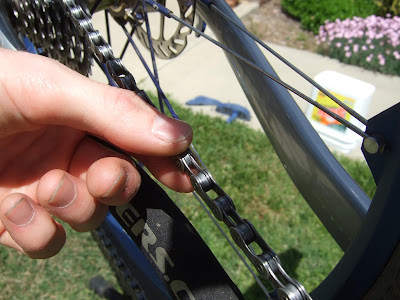 Step 4: Apply a more liberal amount of Teflon lube (red lid). Again hold the bottle to the chain while simultaneously squeezing the bottle gently and spinning the cranks backwards.
Step 4: Apply a more liberal amount of Teflon lube (red lid). Again hold the bottle to the chain while simultaneously squeezing the bottle gently and spinning the cranks backwards.
 Apply the same liberal bead to the other side of the chain under the chain stay.
Apply the same liberal bead to the other side of the chain under the chain stay.
 Step 5: Gently wipe the chain with a clean rag to get rid of the excess Teflon lube. Focus on applying more pressure to the side of the chain when wiping and a small amount of pressure on the top and bottom. This will help to leave the Teflon lube on the outside while not stripping the small amount of Cross Country lube off.
Step 5: Gently wipe the chain with a clean rag to get rid of the excess Teflon lube. Focus on applying more pressure to the side of the chain when wiping and a small amount of pressure on the top and bottom. This will help to leave the Teflon lube on the outside while not stripping the small amount of Cross Country lube off.
 That's all there is to it. Your chain shouldn't look too globby but will have a nice lubricated sheen. Go out and enjoy your superstar lube job. Comments, suggestions, tips, all welcome.
That's all there is to it. Your chain shouldn't look too globby but will have a nice lubricated sheen. Go out and enjoy your superstar lube job. Comments, suggestions, tips, all welcome.
What you need:
Finish Line Cross Country Wet Lube (Green Lid)
Finish Line Teflon (Red Lid)
 Step 1: Always start with a clean drive train. There is no point in slathering more lube over dirt, it's gotta be clean. My bike has been used and has been dirty, this is not a brand spankin' new drive train. So you know it is possible to get a drive train this clean and it's really not that hard. Click here for How-To: Clean your drive train :-)
Step 1: Always start with a clean drive train. There is no point in slathering more lube over dirt, it's gotta be clean. My bike has been used and has been dirty, this is not a brand spankin' new drive train. So you know it is possible to get a drive train this clean and it's really not that hard. Click here for How-To: Clean your drive train :-)  Step 2: Apply a thin bead of Cross Country (green lid). Do this by holding the bottle to the chain and gently squeeze the bottle while simultaneously spinning the cranks backwards. You'll see a thin line of lube coming out and onto the moving chain. Do this for roughly two whole revolutions of the chain being careful not to apply too much. Too much of this lube will make your chain more vulnerable to dirt. The lube will glob up around your cassette and chain rings and pulley wheels and just keep attracting dirt. Apply the same thin bead to the other side of the chain under the chain stay.
Step 2: Apply a thin bead of Cross Country (green lid). Do this by holding the bottle to the chain and gently squeeze the bottle while simultaneously spinning the cranks backwards. You'll see a thin line of lube coming out and onto the moving chain. Do this for roughly two whole revolutions of the chain being careful not to apply too much. Too much of this lube will make your chain more vulnerable to dirt. The lube will glob up around your cassette and chain rings and pulley wheels and just keep attracting dirt. Apply the same thin bead to the other side of the chain under the chain stay. Step 3: Work the Cross Country lube into the chain by rubbing it in with your fingers while spinning the cranks backwards.
Step 3: Work the Cross Country lube into the chain by rubbing it in with your fingers while spinning the cranks backwards. Step 4: Apply a more liberal amount of Teflon lube (red lid). Again hold the bottle to the chain while simultaneously squeezing the bottle gently and spinning the cranks backwards.
Step 4: Apply a more liberal amount of Teflon lube (red lid). Again hold the bottle to the chain while simultaneously squeezing the bottle gently and spinning the cranks backwards. Apply the same liberal bead to the other side of the chain under the chain stay.
Apply the same liberal bead to the other side of the chain under the chain stay. Step 5: Gently wipe the chain with a clean rag to get rid of the excess Teflon lube. Focus on applying more pressure to the side of the chain when wiping and a small amount of pressure on the top and bottom. This will help to leave the Teflon lube on the outside while not stripping the small amount of Cross Country lube off.
Step 5: Gently wipe the chain with a clean rag to get rid of the excess Teflon lube. Focus on applying more pressure to the side of the chain when wiping and a small amount of pressure on the top and bottom. This will help to leave the Teflon lube on the outside while not stripping the small amount of Cross Country lube off. That's all there is to it. Your chain shouldn't look too globby but will have a nice lubricated sheen. Go out and enjoy your superstar lube job. Comments, suggestions, tips, all welcome.
That's all there is to it. Your chain shouldn't look too globby but will have a nice lubricated sheen. Go out and enjoy your superstar lube job. Comments, suggestions, tips, all welcome.
Subscribe to:
Posts (Atom)












